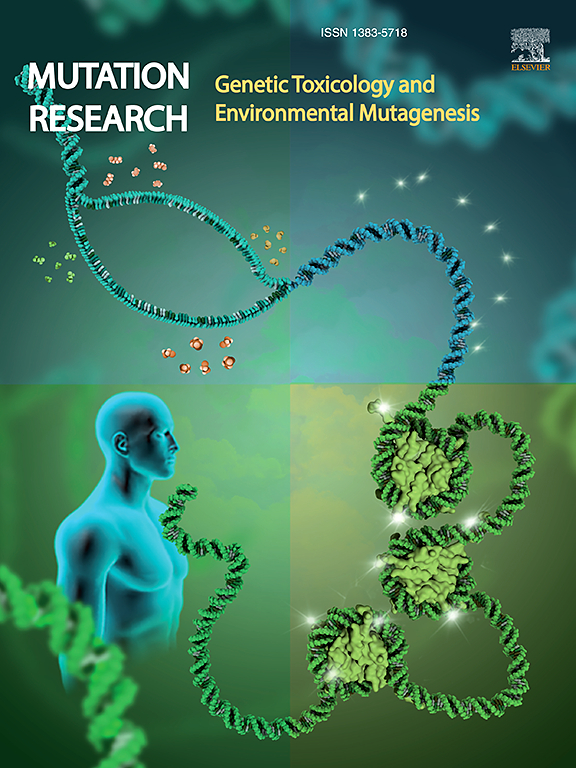Safety evaluation of ethanolic extract from aerial flowering part of spiny globe thistle (Echinops spinosus) in mice: Phytochemical screening and genotoxicity
IF 2.5
4区 医学
Q3 BIOTECHNOLOGY & APPLIED MICROBIOLOGY
Mutation research. Genetic toxicology and environmental mutagenesis
Pub Date : 2025-02-01
DOI:10.1016/j.mrgentox.2025.503854
引用次数: 0
Abstract
Echinops spinosus is widely used by the population due to its therapeutic potential; however, there is no evidence in the literature that substantiates its safety. Therefore, this study aimed to identify the chemical constituents of E. spinosus extract via GC/MS analysis and evaluate its cytotoxicity and genotoxicity. Male mice were orally given three doses of E. spinosus extract (250, 500, and 1000 mg/kg) for four weeks. Blood and tissue samples were collected after the end of treatment. GC–MS results revealed 73 compounds in the E. spinosus extract, including sugars, sugar alcohols, fatty acids, organic acids, amino acids, and nitrogenous compounds. In vitro experiments revealed that E. spinosus was not cytotoxic to human colon, prostate, or breast cancer cells. In vivo experiments showed that E. spinosus extract did not significantly induce chromosomal damage in the bone marrow, primary spermatocyte, or sperm morphology abnormalities at doses up to 1000 mg/kg/day. This extract also did not induce DNA damage at doses ≤ 500 mg/kg/day in the bone marrow, spleen, testis, or spermatozoa and at 250 mg/kg/day in the liver or kidney. However, treatment with a high dose of E. spinosus caused significant disturbances in liver and kidney functions, oxidative stress indicators, comet tail formation, and histological architecture of the liver, kidney, and testis. In conclusion, E. spinosus extract is nontoxic, with an oral LD50 > 5000 mg/kg. The extract showed negative genotoxicity within the safety threshold of ≤ 500 mg/kg/day and positive genotoxicity at a dose of 1000 mg/kg/day.
刺蓟空中开花部分乙醇提取物对小鼠的安全性评价:植物化学筛选和遗传毒性
棘棘因其治疗潜力而被广泛使用;然而,文献中没有证据证明其安全性。因此,本研究旨在通过GC/MS分析鉴定棘棘提取物的化学成分,并评价其细胞毒性和遗传毒性。雄性小鼠口服三种剂量的棘棘提取物(250、500和1000 mg/kg),持续4周。治疗结束后采集血液和组织样本。GC-MS结果显示棘棘提取物中含有73种化合物,包括糖、糖醇、脂肪酸、有机酸、氨基酸和含氮化合物。体外实验表明棘棘杆菌对人结肠癌、前列腺癌和乳腺癌细胞无细胞毒性。体内实验表明,当剂量达到1000 mg/kg/天时,棘棘提取物不会引起骨髓染色体损伤、原代精细胞损伤或精子形态异常。在≤ 500 mg/kg/天的剂量下,该提取物在骨髓、脾脏、睾丸或精子中也不会引起DNA损伤,在250 mg/kg/天的剂量下,在肝脏或肾脏中也不会引起DNA损伤。然而,用高剂量棘棘杆菌治疗会引起肝肾功能、氧化应激指标、彗星尾形成以及肝、肾和睾丸的组织学结构的显著紊乱。综上所述,棘棘提取物无毒,口服LD50 >; 5000 mg/kg。该提取物在≤ 500 mg/kg/day的安全阈值内呈阴性遗传毒性,在1000 mg/kg/day的剂量内呈阳性遗传毒性。
本文章由计算机程序翻译,如有差异,请以英文原文为准。
求助全文
约1分钟内获得全文
求助全文
来源期刊
CiteScore
3.80
自引率
5.30%
发文量
84
审稿时长
105 days
期刊介绍:
Mutation Research - Genetic Toxicology and Environmental Mutagenesis (MRGTEM) publishes papers advancing knowledge in the field of genetic toxicology. Papers are welcomed in the following areas:
New developments in genotoxicity testing of chemical agents (e.g. improvements in methodology of assay systems and interpretation of results).
Alternatives to and refinement of the use of animals in genotoxicity testing.
Nano-genotoxicology, the study of genotoxicity hazards and risks related to novel man-made nanomaterials.
Studies of epigenetic changes in relation to genotoxic effects.
The use of structure-activity relationships in predicting genotoxic effects.
The isolation and chemical characterization of novel environmental mutagens.
The measurement of genotoxic effects in human populations, when accompanied by quantitative measurements of environmental or occupational exposures.
The application of novel technologies for assessing the hazard and risks associated with genotoxic substances (e.g. OMICS or other high-throughput approaches to genotoxicity testing).
MRGTEM is now accepting submissions for a new section of the journal: Current Topics in Genotoxicity Testing, that will be dedicated to the discussion of current issues relating to design, interpretation and strategic use of genotoxicity tests. This section is envisaged to include discussions relating to the development of new international testing guidelines, but also to wider topics in the field. The evaluation of contrasting or opposing viewpoints is welcomed as long as the presentation is in accordance with the journal''s aims, scope, and policies.

 求助内容:
求助内容: 应助结果提醒方式:
应助结果提醒方式:


